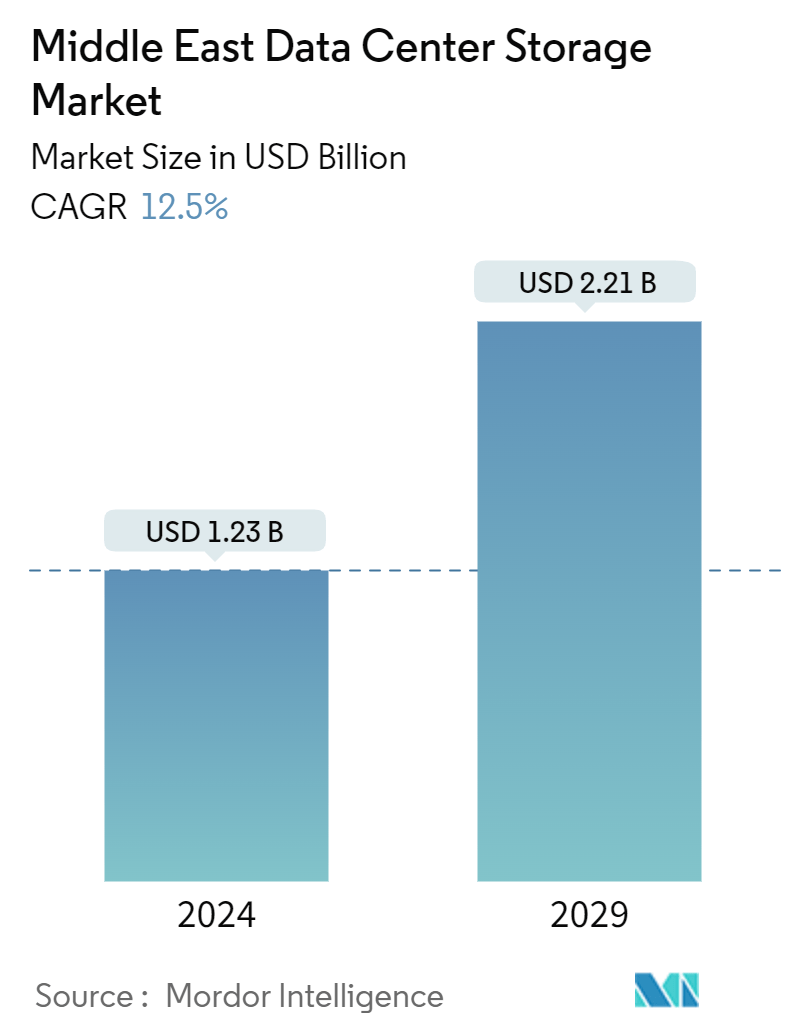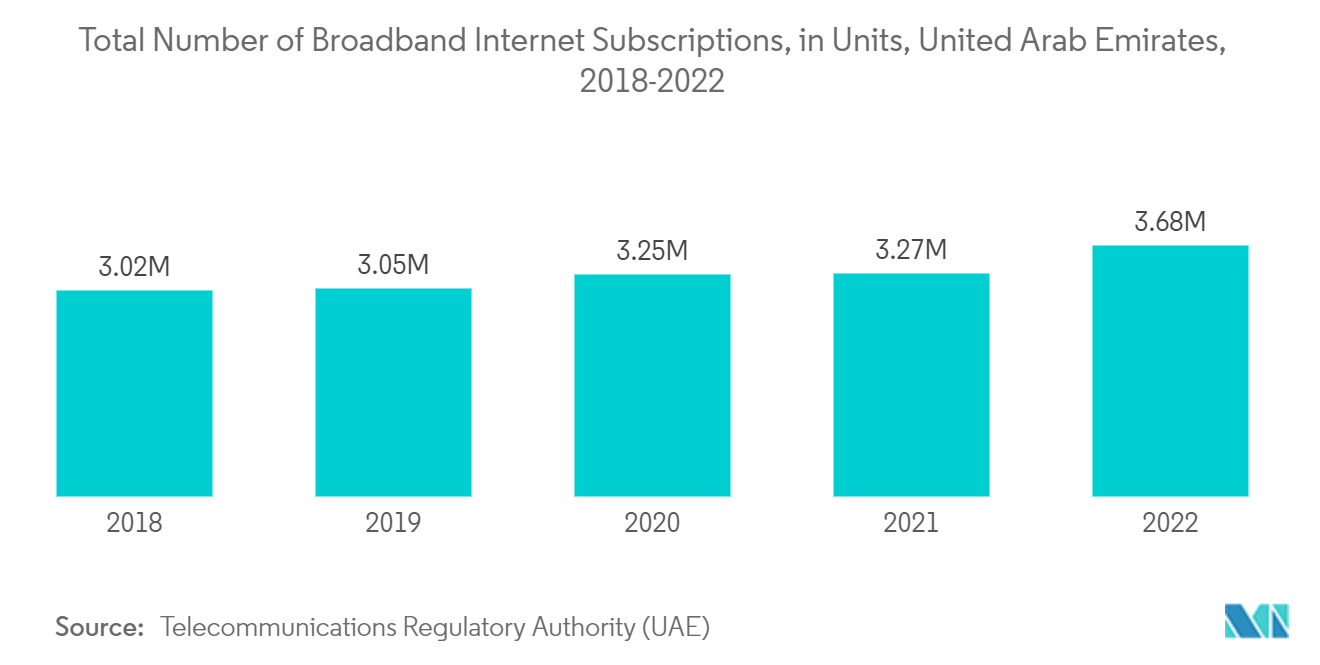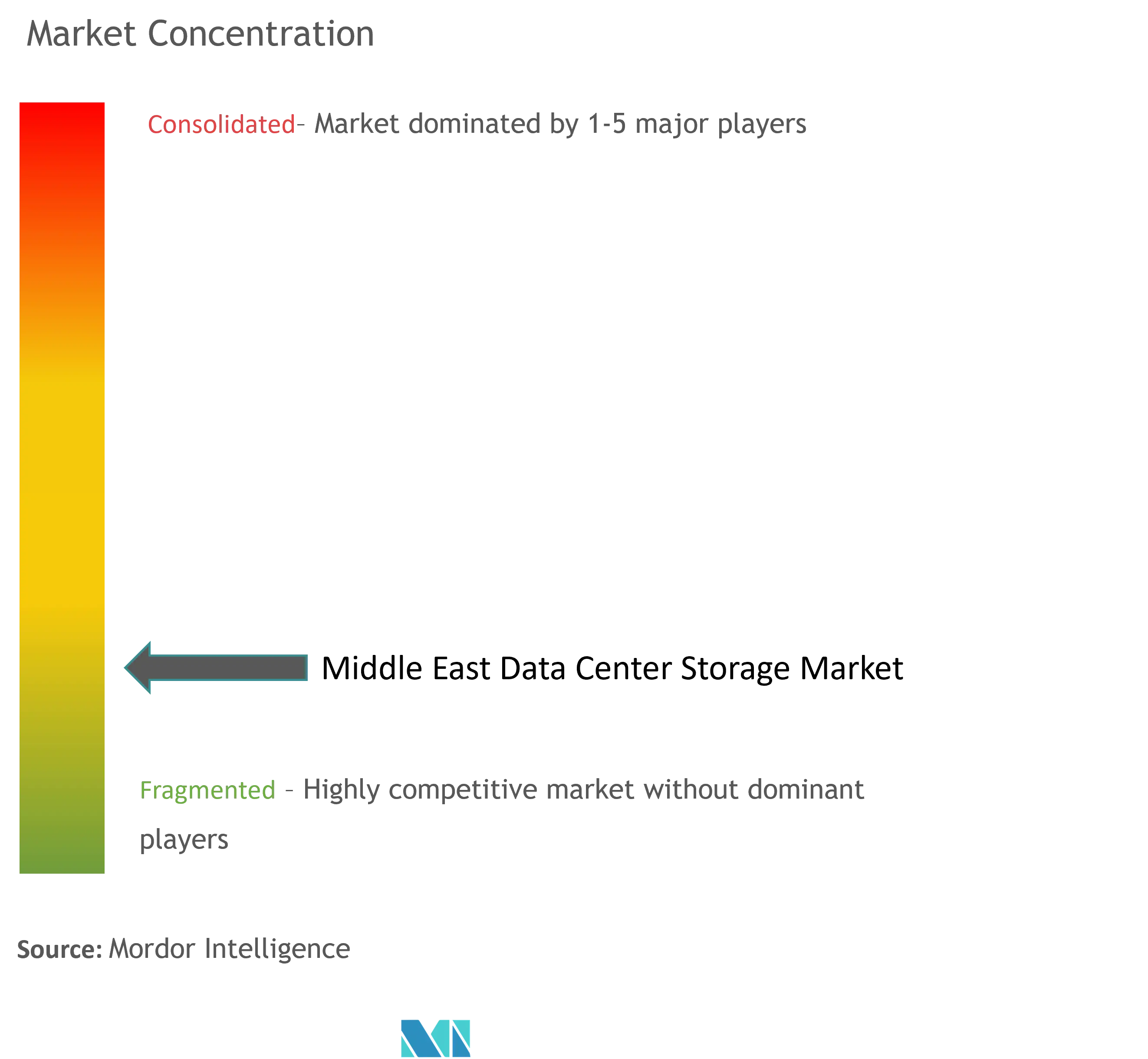Middle East Data Center Storage Market Size

| Study Period | 2018 - 2029 |
| Base Year For Estimation | 2023 |
| Market Size (2024) | USD 1.23 Billion |
| Market Size (2029) | USD 2.21 Billion |
| CAGR (2024 - 2029) | 12.50 % |
| Market Concentration | Low |
Major Players
*Disclaimer: Major Players sorted in no particular order |
Middle East Data Center Storage Market Analysis
The Middle East Data Center Storage Market size is estimated at USD 1.23 billion in 2024, and is expected to reach USD 2.21 billion by 2029, growing at a CAGR of 12.5% during the forecast period (2024-2029).
The Middle East digital economy is projected to grow to about USD 780 billion by 2030, which would significantly outpace the global average through the end of the decade. The United Arab Emirates is one of the largest data center hubs in the Middle East, with the construction of more data centers planned. Upto USD 1 billion in additional investments are projected by 2026. In 2019, Microsoft Azure launched two cloud regions in Dubai and Abu Dhabi. SaaS, being a cloud-based model, provides flexible, scalable, and cost-effective software solutions that can be quickly deployed and aligned with evolving business requirements in the Middle East. Such factors are leading to the growth in market demand.
- The upcoming IT load capacity of the Middle East data center market is expected to reach 2,059.5 MW by 2029.
- The region's construction of raised floor area is expected to increase to 9.7 million sq. ft by 2029.
- The region's total number of racks to be installed is expected to reach 496K units by 2029. Saudi Arabia is expected to house the maximum number of racks by 2029.
- There are close to 26 submarine cable systems connecting the Middle East, and many are under construction. One such submarine cable that is estimated to start service in 2024 is Blue, which stretches over 4,696 kilometers with a landing point in Tel Aviv.
Middle East Data Center Storage Market Trends
IT and Telecom to Hold Significant Share
- The market is characterized by a shift toward software-defined infrastructure, enhancing scalability and agility. As the demand for seamless connectivity rises, telecom companies are poised for sustained expansion in storage equipment.
- The rollout of 5G networks is expected to strengthen the digital economy and increase demand for data center storage infrastructure. The arrival of 5G is expected to bring a major increase in speeds, low latencies, and an unforeseen level of network capabilities. This will set the stage for even more advanced and novel applications, enabling everything to be more connected in real-time.
- Telecom suppliers are encouraged to invest in the data center business by quickly rising 4G adoption and the impending 5G wave. In the United Arab Emirates, there were about 18.7 million active mobile phone subscribers as of March 2022, according to the UAE Telecommunications Regulatory Authority. This figure shows a slight rise from December 2020.
- According to an Ericsson Mobility 2020 estimate, there are likely to be 80 million 5G customers in MENA by 2025. This widespread use benefits companies and other technological advancements in the region and lays the groundwork for smart cities and worldwide communication. Furthermore, the telecom authority in the United Arab Emirates set an ambitious objective of 100% 5G penetration in the country by 2025 in order to become the Middle East's technically prominent player in the networking system.
- 5G is close to seven times better in terms of throughput compared to 4G, at 10 Gbs compared to 1.45 Gbs. With NVMe or SSD over HDD, such enterprise-level technology allows significant I/O throughput. The demand for NVMe is expected to increase in SSD servers and storage appliances, which is expected to drive the market during the forecast period.

Saudi Arabia to Witness Significant Growth
- The growth in data generated by the enterprise, coupled with the growing adoption of cloud technology, is expected to drive market studied in Saudi Arabia. Rapid cloud-based technology adoption is projected to help accelerate the country's digital transition while protecting mountains of data.
- With enticing investments from cloud providers such as Google and Oracle, the data center business has started to pick up steam. For instance, Oracle will work with NEOM Tech & Digital Holding Co. as the first tenant in the hyperscale data center at NEOM to serve Saudi Vision 2030. The data center will house Oracle Cloud Infrastructure (OCI), which would offer a high-performing, resilient platform for cloud services.
- The Saudi government has recognized the demand and accordingly outlined AI as a pillar of Vision 2030. This is part of the country’s strategy to evolve into a knowledge-based society, diversify its oil-based economy, and become a global hub for technological development.
- Around 70% of Vision 2030 strategic goals are closely related to AI. To achieve its mission, Saudi Arabia has led a concerted effort to advance its technological capabilities and to create a domestic AI-enabled digital ecosystem by 2030. The National Strategy for Data and Artificial Intelligence (NSDAI) will seek to attract USD 20 billion in foreign and local investments by 2030.
- Under Saudi Vision 2030, foreign investment is encouraged, particularly in the technology sector. The implementation of the cloud-first strategy in 2019 also accelerated the uptake of innovative technologies such as AI for Industrial 4.0. The Cloud Computing Regulatory Framework, which was adopted by the Communications and Technology Information Commission, intends to improve cloud computing services in the country and promote regulatory openness. Overall, it is expected that with an increase in big data volume through AI and other technology, the demand for data center construction will increase, leading to the major adoption of storage equipment.

Middle East Data Center Storage Industry Overview
The Middle East data center storage market is fragmented among the players and has gained a competitive edge in recent years. Some of the major players are Dell Inc., Hewlett Packard Enterprise, and NetApp Inc., among others. These major players, with a prominent market share, focus on expanding their customer base across the region. These companies leverage strategic collaborative initiatives to increase their market share and profitability. For instance,
- March 2024: Western Digital expanded its product lineup with the introduction of a 24 TB WD Red Pro mechanical hard drive designed specifically for NAS (network attached storage) applications. The company launched a 24TB model earlier, targeted at enterprise and data center use.
- March 2024: Pure Storage launched advanced data storage technologies and services. The company announced new self-service capabilities across its Pure1 storage management platform and Evergreen portfolio, offering software-based solutions, all via a single platform experience, to global customers.
Middle East Data Center Storage Market Leaders
-
Dell Inc.
-
Hewlett Packard Enterprise
-
NetApp Inc.
-
Huawei Technologies Co. Ltd.
-
Kingston Technology Company Inc.
*Disclaimer: Major Players sorted in no particular order

Middle East Data Center Storage Market News
- June 2023: Huawei Technologies Co. Ltd launched its innovative data center data infrastructure architecture F2F2X (flash-to-flash-to-anything) at the Financial Data Storage Session, a part of the Huawei Intelligent Finance Summit 2023 (HiFS 2023). This architecture forms a reliable data foundation to help financial institutions handle the challenges brought by new data, new apps, and new resilience.
- April 2023: Hewlett Packard Enterprise announced new file, block, disaster, and backup recovery data services designed to help customers eliminate data silos, reduce cost and complexity, and improve performance. The new file storage data services deliver scale-out, enterprise-grade performance for data-intensive workloads, and the expanded block services provide mission-critical storage with mid-range economics.
Middle East Data Center Storage Market Report - Table of Contents
1. INTRODUCTION
- 1.1 Study Assumption and Market Definition
- 1.2 Scope of the Study
2. Research Methodology
3. Executive Summary
4. Market Dynamics
- 4.1 Market Overview
-
4.2 Market Drivers
- 4.2.1 Growing Digitalization and Emergence of Data-centric Applications
- 4.2.2 Rising Cloud Applications Among End Users
-
4.3 Market Restraints
- 4.3.1 Compatibility and Optimum Storage Performance Issues
- 4.4 Value Chain/Supply Chain Analysis
-
4.5 Industry Attractiveness - Porter's Five Forces Analysis
- 4.5.1 Threat of New Entrants
- 4.5.2 Bargaining Power of Buyers/Consumers
- 4.5.3 Bargaining Power of Suppliers
- 4.5.4 Threat of Substitute Products
- 4.5.5 Intensity of Competitive Rivalry
- 4.6 Assessment of COVID-19 Impact
5. MARKET SEGMENTATION
-
5.1 By Storage Technology
- 5.1.1 Network Attached Storage (NAS)
- 5.1.2 Storage Area Network (SAN)
- 5.1.3 Direct Attached Storage (DAS)
- 5.1.4 Other Technologies
-
5.2 By Storage Type
- 5.2.1 Traditional Storage
- 5.2.2 All-Flash Storage
- 5.2.3 Hybrid Storage
-
5.3 By End User
- 5.3.1 IT & Telecommunication
- 5.3.2 BFSI
- 5.3.3 Government
- 5.3.4 Media & Entertainment
- 5.3.5 Other End Users
-
5.4 By Country
- 5.4.1 Israel
- 5.4.2 Saudi Arabia
- 5.4.3 United Arab Emirates
6. COMPETITIVE LANDSCAPE
-
6.1 Company Profiles
- 6.1.1 Dell Inc.
- 6.1.2 Hewlett Packard Enterprise
- 6.1.3 NetApp Inc.
- 6.1.4 Huawei Technologies Co. Ltd
- 6.1.5 Kingston Technology Company Inc.
- 6.1.6 Pure Storage Inc.
- 6.1.7 Nutanix Inc.
- 6.1.8 Lenovo Group Limited
- 6.1.9 IBM Corporation
- 6.1.10 SMART Modular Technologies Inc.
- 6.1.11 Infinidat Ltd
- 6.1.12 IBM Corporation
- 6.1.13 Zadara Inc.
- 6.1.14 Western Digital Corporation
- *List Not Exhaustive
7. INVESTMENT ANALYSIS
8. MARKET OPPORTUNITIES AND FUTURE TRENDS
** Subject To AvailablityMiddle East Data Center Storage Industry Segmentation
Data center storage encompasses devices, hardware, networking equipment, and software technologies facilitating the storage of data and applications within data center facilities, which are used for storing, managing, retrieving, distributing, and backing up digital information within such facilities.
The Middle East data center storage market is segmented by storage technology (network attached storage (NAS), storage area network (SAN), and direct attached storage (DAS)), storage type (traditional storage, all-flash storage, hybrid storage), end user (IT & telecommunication, BFSI, government, media & entertainment, and other end users), and country. The market sizes and forecasts are provided in terms of value (USD) for all the above segments.
| By Storage Technology | Network Attached Storage (NAS) |
| Storage Area Network (SAN) | |
| Direct Attached Storage (DAS) | |
| Other Technologies | |
| By Storage Type | Traditional Storage |
| All-Flash Storage | |
| Hybrid Storage | |
| By End User | IT & Telecommunication |
| BFSI | |
| Government | |
| Media & Entertainment | |
| Other End Users | |
| By Country | Israel |
| Saudi Arabia | |
| United Arab Emirates |
Middle East Data Center Storage Market Research FAQs
How big is the Middle East Data Center Storage Market?
The Middle East Data Center Storage Market size is expected to reach USD 1.23 billion in 2024 and grow at a CAGR of 12.5% to reach USD 2.21 billion by 2029.
What is the current Middle East Data Center Storage Market size?
In 2024, the Middle East Data Center Storage Market size is expected to reach USD 1.23 billion.
Who are the key players in Middle East Data Center Storage Market?
Dell Inc., Hewlett Packard Enterprise, NetApp Inc., Huawei Technologies Co. Ltd. and Kingston Technology Company Inc. are the major companies operating in the Middle East Data Center Storage Market.
What years does this Middle East Data Center Storage Market cover, and what was the market size in 2023?
In 2023, the Middle East Data Center Storage Market size was estimated at USD 1.08 billion. The report covers the Middle East Data Center Storage Market historical market size for years: 2018, 2019, 2020, 2021, 2022 and 2023. The report also forecasts the Middle East Data Center Storage Market size for years: 2024, 2025, 2026, 2027, 2028 and 2029.
Middle East Data Center Storage Industry Report
Statistics for the 2024 Middle East Data Center Storage market share, size and revenue growth rate, created by Mordor Intelligence™ Industry Reports. Middle East Data Center Storage analysis includes a market forecast outlook for 2024 to 2029 and historical overview. Get a sample of this industry analysis as a free report PDF download.



